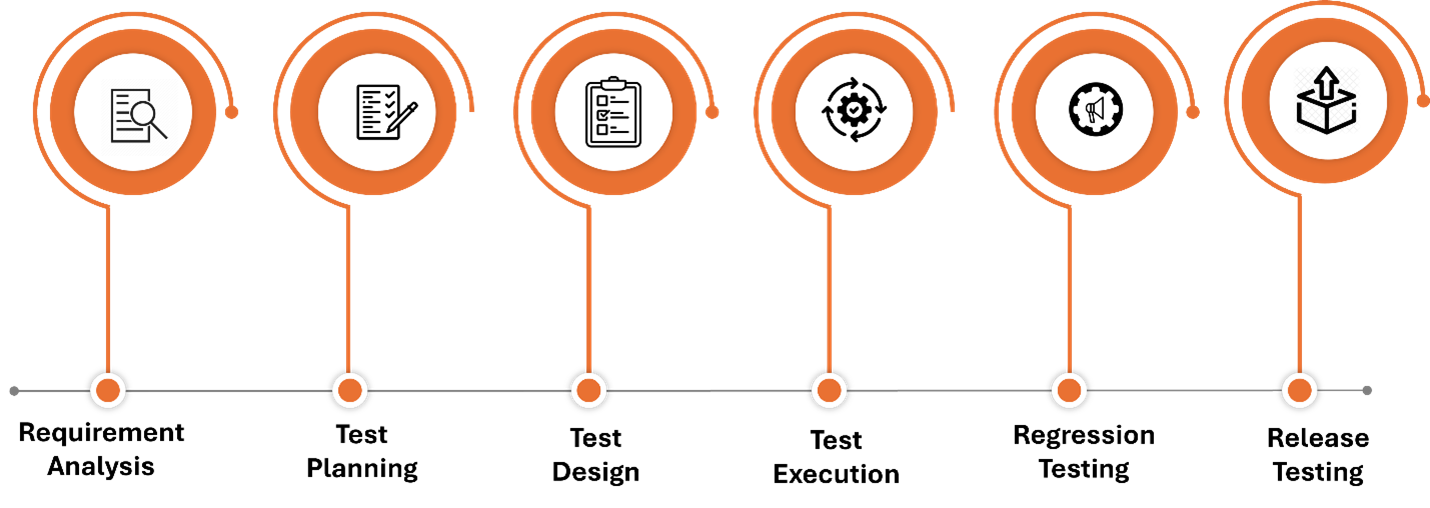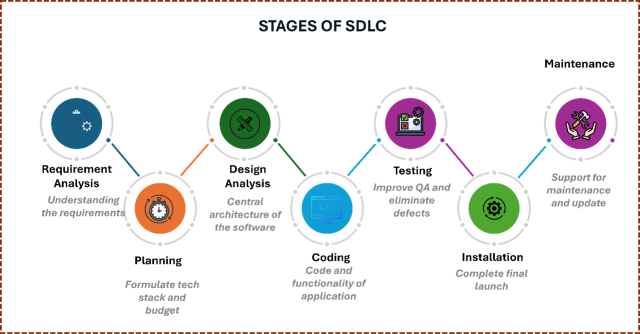Imagine your Quality Assurance (QA) process as a race car. You wouldn’t expect it to win the race without fine-tuning, right? The same applies to your QA process improvement. Just like a race car needs constant adjustments to perform at its best, your QA (Quality Assurance) process requires continuous updates to ensure your business delivers top-notch products.
QA is a key phase in the software product development procedure. Without a proper plan to implement a thorough QA process, will lead to bug-packed releases, customer complaints and dissatisfaction, and time loss.
If you want to release a high quality product, QA must be embedded in your product development lifecycle from the very start. Moreover, each stakeholder who is engaged with the software development process or the project needs to understand its significance. This includes Business or Product Analyst, developers, project managers, test engineers, and even the sales and marketing teams.
Did you know that the according to Kingpin market research, global software testing market size is projected to reach $2,62,620 million by 2028? That’s right!
So, are you aiming to enhance your reputation and customer satisfaction by investing in QA process improvement? Then you’ve landed on the right page. This article will guide you through five ways QA process improvements and more.
Continue reading the blog to explore what is QA process, its significance, and what are the key steps to enhance QA testing process.
What is the QA Process?
QA or Quality Assurance is a formal procedure of enhancing your products in a way that they come out of the best quality.
For instance, take a company that deals with the production of smart home devices. For their QA process, they define the testing plans and schedules to perform testing activities and detect the defects at the earliest stage possible.
This involves planning, executing, and monitoring testing activities to identify and fix defects early. Thus, improving the QA process lets this company offer better smart home products and get an edge over its rivals.
Here is a breakdown of the QA process for a better understanding.

| Stages | Description |
| Requirement Analysis |
|
| Test Planning |
|
| Test Design |
|
| Test Execution & Reporting |
|
| Re-tests & Regression Testing |
|
| Release Testing |
|
Now, it is time to discuss why QA process improvement is essential for your business’s victory.
Importance of QA Process Improvement
Enhancing your QA process is essential to ensure your software products are reliable and successful. Just as thinkJar research says, 67% of consumers cite bad experiences as a reason for churn, ensuring that your software meets high-quality standards can prevent similar negative outcomes for your users. A well-tuned QA process not only helps in delivering a flawless product but also contributes to overall customer satisfaction and retention.
Here are some key reasons why QA process improvement is essential.
- Improved Product Quality: Makes certain that goods fulfill strict requirements and have fewer bugs and errors.
- Boosted Productivity: This has an impact on the testing process by making it more productive, cutting costs and time, and allowing teams to spot and fix problems faster.
- Better Customer Satisfaction: Delivering a top-notch product builds customer trust and happiness while reducing the chances of complaints and returns.
- Cutting Costs: You can save money by finding and fixing problems instead of waiting until after the product is out and then spending more money fixing errors.
- Better Teamwork: It helps QA, developers, and others communicate more often, creating a friendly environment to keep making things better.
- Edge Over Rivals: Great products make your company stand out from others and help you build a strong name for being reliable and high-quality.
With the importance of QA process improvement established, see how it integrates into the software development lifecycle.
QA Process Improvement: Software Development Lifecycle
To completely understand QA process improvements, you need to understand the concept of the Software Development Lifecycle (SDLC). Read the blog on Gen AI in SDLC to explore more details on SDLC.
Consider the SDLC as the recipe for a fine dining experience. Each step of the process is like an ingredient that, when combined with others, makes a tasty meal. Every part of the procedure plays a key role in making sure each element of the program is planned, thought out, built, checked, and put into use.
Time to dive into the details of SDLC for QA process improvement!
QA play a significant role in the testing phase of SDLC, from creating test cases to bug reports. The key activities of QA in testing stage are as follows:
- Writing test cases: Understand in detail each component in the application and write test cases of all the components with possible valis or invalid inputs.
- Writing bug reports: The detailed descriptions about the identified bugs or defects should be documented with screenshots.
- Keeping track of all updates
- Prioritizing customer-supported browsers and devices.
Now that you have understood the basics of SDLC, it’s time you dive into the five steps for enhancing your QA process.
5 Steps to Testing and QA Process Improvement
QA process improvement is about honing your strategy so that each component functions.
If your company doesn’t have a strong quality assurance process, it may result in undercooked products that leave a poor taste in the mouths of your customers.
To avoid such a mishap, get into the details of the steps of QA process improvement testing.
Step 1: Define Clear Objectives
Establish cohesive goals for your QA process to align with your organization’s trajectory and future accomplishments.
QA engineers need to understand what you hope to achieve. Detail your approach to coding standards, QA best practices, and testing methodologies like User Acceptance Testing (UAT) and Exploratory Testing to ensure everyone is on the same page and to foster employee buy-in.
Step 2: Establish Communication and Reporting Practices
Set up thorough documentation and communication channels among developer teams, QA providers, QA engineers, project managers, and stakeholders. Create standardized formats for reporting to ensure clear and consistent communication during the testing phase.
Effective communication prevents misunderstandings and ensures the QA process adds value.
Step 3: Shift Left and Automate
Involve QA teams from the start of the project, a practice known as shift-left testing. Begin testing early and consistently throughout the software development lifecycle to reduce costs and maintain a smooth project pipeline. Invest in automation tools, such as generative AI for testing, to optimize costs, increase test coverage, speed up the QA cycle, and enable low-cost, repeatable testing.
Step 4: Develop Test Planning Strategies
Create detailed test plans specific to QA, covering all testing phases as given below.
- Regression Testing: Ensure new changes do not alter existing functionality. Define success metrics such as the number of bugs found and fixed, the percentage of test coverage, and the time taken for regression testing.
- Performance Testing: Establish baseline measures for load testing in critical user scenarios, simulating real-world conditions.
- Security Testing: Conduct tests across all attack vectors and engage in data protection, penetration, compliance, and dependency scanning.
- User Acceptance Testing (UAT): Develop usability test scripts for various customer scenarios, focusing on usability and incorporating robust feedback mechanisms.
Step 5: Continuously Improve Through Monitoring, Auditing, and Feedback
Implement feedback loops and knowledge transfers to collect insights from all departments, ensuring comprehensive QA process improvement.
- Regularly monitor and audit the QA process, keeping up with compliance checklists and maintaining audit trails.
- Continuously iterate on these steps, using lessons learned to improve the QA process, train employees, and enhance product quality consistently.
With these five steps in mind, explore how to implement QA process improvement in your organization effectively.
How to Implement QA Process Improvement in Your Organization?
In the world today, putting out perfect products isn’t just something to aim for — it’s a must. Still, many companies struggle with QA methods that don’t work well. These can slow things down and hurt how good their products are. So, what can you do to fix this?
Implementing a solid QA process improvement strategy can be a game-changer, helping you streamline operations, enhance product reliability, and, ultimately, delight your customers.
Here are some actionable tips to consider for the effective final implementation of QA process improvement.
Adopt Test Automation Tools
Using great tech with automated testing tools plays a big role in making your QA better. Testing by hand over and over can eat up time and lead to mistakes. When you team up with talented coders to build a custom fix, you can make these jobs smoother. Making things automatic doesn’t just speed up testing. It also makes it more spot-on. This lets your QA crew zero in on trickier problems and get more done overall.
Our experts build and execute automated tests, ensuring high-quality software delivery within budget and timelines.
Implement Shift-Left Testing
Shift-left moves testing to an earlier point in the development process. When you include testing from the start, like ongoing code reviews and unit tests, you can spot and fix problems sooner.
This approach reduces the need for extensive testing and code revisions later in the software development lifecycle (SDLC), ultimately saving costs and time. Adopting shift-left practices ensures that quality is built into the product from the start rather than being inspected only at the end.
Create a QA Process Improvement Plan
A well-formulated QA process improvement plan is crucial for enhancing efficiency, reducing costs, and saving time. Your plan should encompass various strategies, including test automation, regression testing, metric evaluation, user acceptance testing, synthetic data analysis, and efficient data management.
Assigning these tasks to a competent QA Manager ensures that all aspects of the plan are implemented effectively and kept up to date. This structured approach will lead to significant improvements in your QA process.
Minimize Testing Maintenance
Reducing testing maintenance is essential for a smooth QA process. Issues like unstable XPath or CSS (Cascading Style Sheets) locators can impede testing efficiency. To combat this, use AI-powered tools that can automatically update test scripts and minimize manual intervention, thereby reducing maintenance costs.
Additionally, adopting design-driven testing — where tests are created before code development — can help in identifying defects early and make possible quicker iterations. This approach enhances the quality of testing and ensures a more efficient QA process.
Having established effective implementation strategies, read on some challenges in the QA process.
What Are the Challenges in the QA Process?
Ensuring the quality of software products is crucial but challenging. The QA process involves meticulous planning, execution, and analysis to guarantee that software meets the required standards. Despite best efforts, several obstacles, listed below, can impede this process.
- Complexity of Software: Modern software systems are intricate, making comprehensive testing difficult.
- Limited Resources: Constraints in budget, time, and personnel can affect the thoroughness of QA efforts.
- Evolving Requirements: Frequent changes in requirements can lead to gaps in test coverage.
- Integration Issues: Ensuring compatibility across various platforms and environments can be challenging.
- Bug Reproduction: Identifying and reproducing bugs consistently can be time-consuming and difficult.
Given these challenges, explore how improving the QA process can provide significant benefits.
The Ultimate Benefits of QA Process Improvement
Putting into action a range of top methods to improve your quality assurance process can be tough, even for skilled QA teams. Instead, you can make a few key tweaks to your current approach to get the best outcomes.
After you improve your QA process, you’ll see these benefits.
- Your organization becomes more productive.
- Clients have a better experience due to a bug-free digital product.
- You avoid software crashes and roadblocks in the final rollout.
- You lower risks and have a better chance of delivering an error-free digital experience.
All these perks lead to happier customers. As a result, you’ll see your profits go up and your company’s image get stronger when you focus on improving your QA process.
With these benefits in mind, explore real-world examples of how QA process improvement has transformed businesses.
Summary
In the ongoing quest to perfect products, Quality Assurance (QA) isn’t just a box to tick — it’s a never-ending journey to get better. An improved QA process transforms into an enhanced Software Development Life Cycle. Proper testing strategies can ensure a high standard of end-product quality. This in turn realise faster times to market, cost reductions, and enhanced customer satisfaction.
However, enhancing QA is a complicated task. Ready to elevate your QA process? Calsoft being a technology-first partner streamlines your testing process for faster and more reliable software delivery with our skilled QA services and new ideas that aim to boost your product quality and effectiveness. Let’s team up to improve your QA process!





